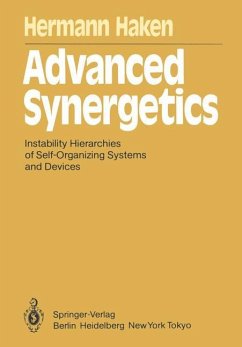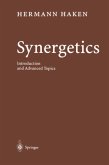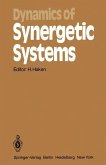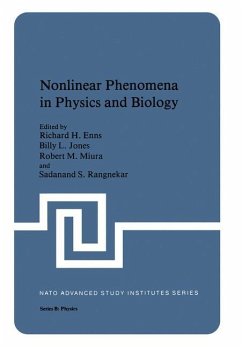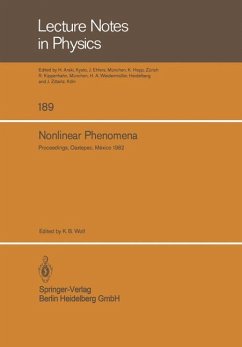- Broschiertes Buch
- Merkliste
- Auf die Merkliste
- Bewerten Bewerten
- Teilen
- Produkt teilen
- Produkterinnerung
- Produkterinnerung
This text on the interdisciplinary field of synergetics will be of interest to students and scientists in physics, chemistry, mathematics, biology, electrical, civil and mechanical engineering, and other fields. It continues the outline of basic con cepts and methods presented in my book Synergetics. An Introduction, which has by now appeared in English, Russian, J apanese, Chinese, and German. I have written the present book in such a way that most of it can be read in dependently of my previous book, though occasionally some knowledge of that book might be useful. But why do these books…mehr
Andere Kunden interessierten sich auch für
![Synergetics Synergetics]() Hermann HakenSynergetics92,99 €
Hermann HakenSynergetics92,99 €![Synergetics Synergetics]() Hermann HakenSynergetics83,99 €
Hermann HakenSynergetics83,99 €![Selforganization by Nonlinear Irreversible Processes Selforganization by Nonlinear Irreversible Processes]() Selforganization by Nonlinear Irreversible Processes77,99 €
Selforganization by Nonlinear Irreversible Processes77,99 €![Dynamics of Synergetic Systems Dynamics of Synergetic Systems]() Dynamics of Synergetic Systems77,99 €
Dynamics of Synergetic Systems77,99 €![Nonlinear Phenomena in Physics and Biology Nonlinear Phenomena in Physics and Biology]() Nonlinear Phenomena in Physics and Biology39,99 €
Nonlinear Phenomena in Physics and Biology39,99 €![Nonlinear Phenomena Nonlinear Phenomena]() Nonlinear Phenomena39,99 €
Nonlinear Phenomena39,99 €![Synergetics of the Brain Synergetics of the Brain]() Synergetics of the Brain77,99 €
Synergetics of the Brain77,99 €-
-
-
This text on the interdisciplinary field of synergetics will be of interest to students and scientists in physics, chemistry, mathematics, biology, electrical, civil and mechanical engineering, and other fields. It continues the outline of basic con cepts and methods presented in my book Synergetics. An Introduction, which has by now appeared in English, Russian, J apanese, Chinese, and German. I have written the present book in such a way that most of it can be read in dependently of my previous book, though occasionally some knowledge of that book might be useful. But why do these books address such a wide audience? Why are instabilities such a common feature, and what do devices and self-organizing systems have in common? Self-organizing systems acquire their structures or functions without specific interference from outside. The differentiation of cells in biology, and the process of evolution are both examples of self-organization. Devices such as the electronic oscillators used in radio transmitters, on the other hand, are man made. But we often forget that in many cases devices function by means of pro cesses which are also based on self-organization. In an electronic oscillator the motion of electrons becomes coherent without any coherent driving force from the outside; the device is constructed in such a way as to permit specific collective motions of the electrons. Quite evidently the dividing line between self-organiz ing systems and man-made devices is not at all rigid.
Hinweis: Dieser Artikel kann nur an eine deutsche Lieferadresse ausgeliefert werden.
Hinweis: Dieser Artikel kann nur an eine deutsche Lieferadresse ausgeliefert werden.
Produktdetails
- Produktdetails
- Springer Series in Synergetics .20
- Verlag: Springer / Springer Berlin Heidelberg / Springer, Berlin
- Artikelnr. des Verlages: 978-3-642-45555-1
- Softcover reprint of the original 1st ed. 1983
- Seitenzahl: 376
- Erscheinungstermin: 3. März 2012
- Englisch
- Abmessung: 244mm x 170mm x 21mm
- Gewicht: 647g
- ISBN-13: 9783642455551
- ISBN-10: 3642455557
- Artikelnr.: 36117311
- Herstellerkennzeichnung Die Herstellerinformationen sind derzeit nicht verfügbar.
- Springer Series in Synergetics .20
- Verlag: Springer / Springer Berlin Heidelberg / Springer, Berlin
- Artikelnr. des Verlages: 978-3-642-45555-1
- Softcover reprint of the original 1st ed. 1983
- Seitenzahl: 376
- Erscheinungstermin: 3. März 2012
- Englisch
- Abmessung: 244mm x 170mm x 21mm
- Gewicht: 647g
- ISBN-13: 9783642455551
- ISBN-10: 3642455557
- Artikelnr.: 36117311
- Herstellerkennzeichnung Die Herstellerinformationen sind derzeit nicht verfügbar.
Hermann Haken is Professor of the Institute for Theoretical Physics at the University of Stuttgart. He is known as the founder of synergetics. His research has been in nonlinear optics (in particular laser physics), solid state physics, statistical physics, and group theory. After the implementation of the first laser in 1960, Professor Haken developed his institute to an international center for laser theory. The interpretation of the laser principles as self organization of non equilibrium systems paved the way to the development of synergetics, of which Haken is recognized as the founder. Hermann Haken has been visiting professor or guest scientist in England, France, Japan, USA, Russia, and China. He is the author of some 23 textbooks and monographs that cover an impressive number of topics from laser physics to synergetics, and editor of a book series in synergetics. For his pathbreaking work and his influence on academic research, he has been awarded many-times. Among others
, he is member of the Order "Pour le merite" and received the Max Planck Medal in 1990.
, he is member of the Order "Pour le merite" and received the Max Planck Medal in 1990.
1. Introduction.- 1.1 What is Synergetics About?.- 1.2 Physics.- 1.2.1 Fluids: Formation of Dynamic Patterns.- 1.2.2 Lasers: Coherent Oscillations.- 1.2.3 Plasmas: A Wealth of Instabilities.- 1.2.4 Solid-State Physics: Multistability, Pulses, Chaos.- 1.3 Engineering.- 1.3.1 Civil, Mechanical, and Aero-Space Engineering: Post-Buckling Patterns, Flutter, etc.- 1.3.2 Electrical Engineering and Electronics: Nonlinear Oscillations.- 1.4 Chemistry: Macroscopic Patterns.- 1.5 Biology.- 1.5.1 Some General Remarks.- 1.5.2 Morphogenesis.- 1.5.3 Population Dynamics.- 1.5.4 Evolution.- 1.5.5 Immune System.- 1.6 Computer Sciences.- 1.6.1 Self-Organization of Computers, in Particular Parallel Computing.- 1.6.2 Pattern Recognition by Machines.- 1.6.3 Reliable Systems from Unreliable Elements.- 1.7 Economy.- 1.8 Ecology.- 1.9 Sociology.- 1.10 What are the Common Features of the Above Examples?.- 1.11 The Kind of Equations We Want to Study.- 1.11.1 Differential Equations.- 1.11.2 First-Order Differential Equations.- 1.11.3 Nonlinearity.- 1.11.4 Control Parameters.- 1.11.5 Stochasticity.- 1.11.6 Many Components and the Mezoscopic Approach.- 1.12 How to Visualize the Solutions.- 1.13 Qualitative Changes: General Approach.- 1.14 Qualitative Changes: Typical Phenomena.- 1.14.1 Bifurcation from One Node (or Focus) into Two Nodes (or Foci).- 1.14.2 Bifurcation from a Focus into a Limit Cycle (Hopf Bifurcation).- 1.14.3 Bifurcations from a Limit Cycle.- 1.14.4 Bifurcations from a Torus to Other Tori.- 1.14.5 Chaotic Attractors.- 1.14.6 Lyapunov Exponents *.- 1.15 The Impact of Fluctuations (Noise). Nonequilibrium Phase Transitions.- 1.16 Evolution of Spatial Patterns.- 1.17 Discrete Maps. The Poincaré Map.- 1.18 Discrete Noisy Maps.- 1.19 Pathways to Self-Organization.- 1.19.1Self-Organization Through Change of Control Parameters.- 1.19.2 Self-Organization Through Change of Number of Components.- 1.19.3 Self-Organization Through Transients.- 1.20 How We Shall Proceed.- 2. Linear Ordinary Differential Equations.- 2.1 Examples of Linear Differential Equations: The Case of a Single Variable.- 2.1.1 Linear Differential Equation with Constant Coefficient.- 2.1.2 Linear Differential Equation with Periodic Coefficient.- 2.1.3 Linear Differential Equation with Quasiperiodic Coefficient.- 2.1.4 Linear Differential Equation with Real Bounded Coefficient.- 2.2 Groups and Invariance.- 2.3 Driven Systems.- 2.4 General Theorems on Algebraic and Differential Equations.- 2.4.1 The Form of the Equations.- 2.4.2 Jordan's Normal Form.- 2.4.3 Some General Theorems on Linear Differential Equations.- 2.4.4 Generalized Characteristic Exponents and Lyapunov Exponents.- 2.5 Forward and Backward Equations: Dual Solution Spaces.- 2.6 Linear Differential Equations with Constant Coefficients.- 2.7 Linear Differential Equations with Periodic Coefficients.- 2.8 Group Theoretical Interpretation.- 2.9 Perturbation Approach*.- 3. Linear Ordinary Differential Equations with Quasiperiodic Coefficients*.- 3.1 Formulation of the Problem and of Theorem 3.- 3.2 Auxiliary Theorems (Lemmas).- 3.3 Proof of Assertion (a) of Theorem 3.1.1: Construction of a Triangular Matrix: Example of a 2 × 2 Matrix.- 3.4 Proof that the Elements of the Triangular Matrix C are Quasiperiodic in ? (and Periodic in ?j and Ck with Respect to ?: Exampleof a 2 × 2 Matrix.- 3.5 Construction of the Triangular Matrix C and Proof that Its Elements are Quasiperiodic in ? (and Periodic in ?j and Ck with Respect to ?): The Case of an m × m Matrix, all A's Different.- 3.6 Approximation Methods.Smoothing.- 3.6.1 A Variational Method.- 3.6.2 Smoothing.- 3.7 The Triangular Matrix C and Its Reduction.- 3.8 The General Case: Some of the Generalized Characteristic Exponents Coincide.- 3.9 Explicit Solution of (3.1.1) by an Iteration Procedure.- 4. Stochastic Nonlinear Differential Equations.- 4.1 An Example.- 4.2 The Îto Differential Equation and the Îto-Fokker-Planck Equation.- 4.3 The Stratonovich Calculus.- 4.4 Langevin Equations and Fokker-Planck Equation.- 5. The World of Coupled Nonlinear Oscillators.- 5.1 Linear Oscillators Coupled Together.- 5.1.1 Linear Oscillators with Linear Coupling.- 5.1.2 Linear Oscillators with Nonlinear Coupling. An Example. Frequency Shifts.- 5.2 Perturbations of Quasiperiodic Motion for Time-Independent Amplitudes (Quasiperiodic Motion Shall Persist).- 5.3 Some Considerations on the Convergence of the Procedure*.- 6. Nonlinear Coupling of Oscillators: The Case of Persistence of Quasiperiodic Motion.- 6.1 The Problem.- 6.2 Moser's Theorem (Theorem 6.2.1).- 6.3 The Iteration Procedure*.- 7. Nonlinear Equations. The Slaving Principle.- 7.1 An Example.- 7.1.1 The Adiabatic Approximation.- 7.1.2 Exact Elimination Procedure.- 7.2 The General Form of the Slaving Principle. Basic Equations.- 7.3 Formal Relations.- 7.4 The Iteration Procedure.- 7.5 An Estimate of the Rest Term. The Question of Differentiability.- 7.6 Slaving Principle for Discrete Noisy Maps*.- 7.7 Formal Relations*.- 7.8 The Iteration Procedure for the Discrete Case*.- 7.9 Slaving Principle for Stochastic Differential Equations*.- 8. Nonlinear Equations. Qualitative Macroscopic Changes.- 8.1 Bifurcations from a Node or Focus. Basic Transformations.- 8.2 A Simple Real Eigenvalue Becomes Positive.- 8.3 Multiple Real Eigenvalues Become Positive.- 8.4 A Simple ComplexEigenvalue Crosses the Imaginary Axis. Hopf Bifurcation.- 8.5 Hopf Bifurcation, Continued.- 8.6 Frequency Locking Between Two Oscillators.- 8.7 Bifurcation from a Limit Cycle.- 8.8 Bifurcation from a Limit Cycle: Special Cases.- 8.8.1 Bifurcation into Two Limit Cycles.- 8.8.2 Period Doubling.- 8.8.3 Subharmonics.- 8.8.4 Bifurcation to a Torus.- 8.9 Bifurcation from a Torus (Quasiperiodic Motion).- 8.10 Bifurcation from a Torus: Special Cases.- 8.10.1 A Simple Real Eigenvalue Becomes Positive.- 8.10.2 A Complex Nondegenerate Eigenvalue Crosses the Imaginary Axis.- 8.11 Instability Hierarchies, Scenarios, and Routes to Turbulence.- 8.11.1 The Landau-Hopf Picture.- 8.11.2 The Ruelle and Takens Picture.- 8.11.3 Bifurcations of Tori. Quasiperiodic Motions.- 8.11.4 The Period-Doubling Route to Chaos. Feigenbaum Sequence.- 8.11.5 The Route via Intermittency.- 9. Spatial Patterns.- 9.1 The Basic Differential Equations.- 9.2 The General Method of Solution.- 9.3 Bifurcation Analysis for Finite Geometries.- 9.4 Generalized Ginzburg-Landau Equations.- 9.5 A Simplification of Generalized Ginzburg-Landau Equations. Pattern Formation in Bénard Convection.- 10. The Inclusion of Noise.- 10.1 The General Approach.- 10.2 A Simple Example.- 10.3 Computer Solution of a Fokker-Planck Equation for a Complex Order Parameter.- 10.4 Some Useful General Theorems on the Solutions of Fokker-Planck Equations.- 10.4.1 Time-Dependent and Time-Independent Solutions of the Fokker-Planck Equation, if the Drift Coefficients are Linear in the Coordinates and the Diffusion Coefficients Constant.- 10.4.2 Exact Stationary Solution of the Fokker-Planck Equation for Systems in Detailed Balance.- 10.4.3 AnExample.- 10.4.4 Useful Special Cases.- 10.5 Nonlinear Stochastic Systems Close to Critical Points: ASummary.- 11. Discrete Noisy Maps.- 11.1 Chapman-Kolmogorov Equation.- 11.2 The Effect of Boundaries. One-Dimensional Example.- 11.3 Joint Probability and Transition Probability. Forward and Backward Equation 305.- 11.4 Connection with Fredholm Integral Equation 306.- 11.5 Path Integral Solution 307.- 11.6 The Mean First Passage Time 308.- 11.7 Linear Dynamics and Gaussian Noise. Exact Time-Dependent Solution of the Chapman-Kolmogorov Equation 310.- 12. Example of an Unsolvable Problem in Dynamics.- 13. Some Comments on the Relation Between Synergetics and Other Sciences.- Appendix A: Moser's Proof of His Theorem.- A.1 Convergence of the Fourier Series.- A.2 The Most General Solution to the Problem of Theorem.- A.3 Convergent Construction.- A.4 Proof of Theorem.- References.
1. Introduction.- 1.1 What is Synergetics About?.- 1.2 Physics.- 1.2.1 Fluids: Formation of Dynamic Patterns.- 1.2.2 Lasers: Coherent Oscillations.- 1.2.3 Plasmas: A Wealth of Instabilities.- 1.2.4 Solid-State Physics: Multistability, Pulses, Chaos.- 1.3 Engineering.- 1.3.1 Civil, Mechanical, and Aero-Space Engineering: Post-Buckling Patterns, Flutter, etc.- 1.3.2 Electrical Engineering and Electronics: Nonlinear Oscillations.- 1.4 Chemistry: Macroscopic Patterns.- 1.5 Biology.- 1.5.1 Some General Remarks.- 1.5.2 Morphogenesis.- 1.5.3 Population Dynamics.- 1.5.4 Evolution.- 1.5.5 Immune System.- 1.6 Computer Sciences.- 1.6.1 Self-Organization of Computers, in Particular Parallel Computing.- 1.6.2 Pattern Recognition by Machines.- 1.6.3 Reliable Systems from Unreliable Elements.- 1.7 Economy.- 1.8 Ecology.- 1.9 Sociology.- 1.10 What are the Common Features of the Above Examples?.- 1.11 The Kind of Equations We Want to Study.- 1.11.1 Differential Equations.- 1.11.2 First-Order Differential Equations.- 1.11.3 Nonlinearity.- 1.11.4 Control Parameters.- 1.11.5 Stochasticity.- 1.11.6 Many Components and the Mezoscopic Approach.- 1.12 How to Visualize the Solutions.- 1.13 Qualitative Changes: General Approach.- 1.14 Qualitative Changes: Typical Phenomena.- 1.14.1 Bifurcation from One Node (or Focus) into Two Nodes (or Foci).- 1.14.2 Bifurcation from a Focus into a Limit Cycle (Hopf Bifurcation).- 1.14.3 Bifurcations from a Limit Cycle.- 1.14.4 Bifurcations from a Torus to Other Tori.- 1.14.5 Chaotic Attractors.- 1.14.6 Lyapunov Exponents *.- 1.15 The Impact of Fluctuations (Noise). Nonequilibrium Phase Transitions.- 1.16 Evolution of Spatial Patterns.- 1.17 Discrete Maps. The Poincaré Map.- 1.18 Discrete Noisy Maps.- 1.19 Pathways to Self-Organization.- 1.19.1Self-Organization Through Change of Control Parameters.- 1.19.2 Self-Organization Through Change of Number of Components.- 1.19.3 Self-Organization Through Transients.- 1.20 How We Shall Proceed.- 2. Linear Ordinary Differential Equations.- 2.1 Examples of Linear Differential Equations: The Case of a Single Variable.- 2.1.1 Linear Differential Equation with Constant Coefficient.- 2.1.2 Linear Differential Equation with Periodic Coefficient.- 2.1.3 Linear Differential Equation with Quasiperiodic Coefficient.- 2.1.4 Linear Differential Equation with Real Bounded Coefficient.- 2.2 Groups and Invariance.- 2.3 Driven Systems.- 2.4 General Theorems on Algebraic and Differential Equations.- 2.4.1 The Form of the Equations.- 2.4.2 Jordan's Normal Form.- 2.4.3 Some General Theorems on Linear Differential Equations.- 2.4.4 Generalized Characteristic Exponents and Lyapunov Exponents.- 2.5 Forward and Backward Equations: Dual Solution Spaces.- 2.6 Linear Differential Equations with Constant Coefficients.- 2.7 Linear Differential Equations with Periodic Coefficients.- 2.8 Group Theoretical Interpretation.- 2.9 Perturbation Approach*.- 3. Linear Ordinary Differential Equations with Quasiperiodic Coefficients*.- 3.1 Formulation of the Problem and of Theorem 3.- 3.2 Auxiliary Theorems (Lemmas).- 3.3 Proof of Assertion (a) of Theorem 3.1.1: Construction of a Triangular Matrix: Example of a 2 × 2 Matrix.- 3.4 Proof that the Elements of the Triangular Matrix C are Quasiperiodic in ? (and Periodic in ?j and Ck with Respect to ?: Exampleof a 2 × 2 Matrix.- 3.5 Construction of the Triangular Matrix C and Proof that Its Elements are Quasiperiodic in ? (and Periodic in ?j and Ck with Respect to ?): The Case of an m × m Matrix, all A's Different.- 3.6 Approximation Methods.Smoothing.- 3.6.1 A Variational Method.- 3.6.2 Smoothing.- 3.7 The Triangular Matrix C and Its Reduction.- 3.8 The General Case: Some of the Generalized Characteristic Exponents Coincide.- 3.9 Explicit Solution of (3.1.1) by an Iteration Procedure.- 4. Stochastic Nonlinear Differential Equations.- 4.1 An Example.- 4.2 The Îto Differential Equation and the Îto-Fokker-Planck Equation.- 4.3 The Stratonovich Calculus.- 4.4 Langevin Equations and Fokker-Planck Equation.- 5. The World of Coupled Nonlinear Oscillators.- 5.1 Linear Oscillators Coupled Together.- 5.1.1 Linear Oscillators with Linear Coupling.- 5.1.2 Linear Oscillators with Nonlinear Coupling. An Example. Frequency Shifts.- 5.2 Perturbations of Quasiperiodic Motion for Time-Independent Amplitudes (Quasiperiodic Motion Shall Persist).- 5.3 Some Considerations on the Convergence of the Procedure*.- 6. Nonlinear Coupling of Oscillators: The Case of Persistence of Quasiperiodic Motion.- 6.1 The Problem.- 6.2 Moser's Theorem (Theorem 6.2.1).- 6.3 The Iteration Procedure*.- 7. Nonlinear Equations. The Slaving Principle.- 7.1 An Example.- 7.1.1 The Adiabatic Approximation.- 7.1.2 Exact Elimination Procedure.- 7.2 The General Form of the Slaving Principle. Basic Equations.- 7.3 Formal Relations.- 7.4 The Iteration Procedure.- 7.5 An Estimate of the Rest Term. The Question of Differentiability.- 7.6 Slaving Principle for Discrete Noisy Maps*.- 7.7 Formal Relations*.- 7.8 The Iteration Procedure for the Discrete Case*.- 7.9 Slaving Principle for Stochastic Differential Equations*.- 8. Nonlinear Equations. Qualitative Macroscopic Changes.- 8.1 Bifurcations from a Node or Focus. Basic Transformations.- 8.2 A Simple Real Eigenvalue Becomes Positive.- 8.3 Multiple Real Eigenvalues Become Positive.- 8.4 A Simple ComplexEigenvalue Crosses the Imaginary Axis. Hopf Bifurcation.- 8.5 Hopf Bifurcation, Continued.- 8.6 Frequency Locking Between Two Oscillators.- 8.7 Bifurcation from a Limit Cycle.- 8.8 Bifurcation from a Limit Cycle: Special Cases.- 8.8.1 Bifurcation into Two Limit Cycles.- 8.8.2 Period Doubling.- 8.8.3 Subharmonics.- 8.8.4 Bifurcation to a Torus.- 8.9 Bifurcation from a Torus (Quasiperiodic Motion).- 8.10 Bifurcation from a Torus: Special Cases.- 8.10.1 A Simple Real Eigenvalue Becomes Positive.- 8.10.2 A Complex Nondegenerate Eigenvalue Crosses the Imaginary Axis.- 8.11 Instability Hierarchies, Scenarios, and Routes to Turbulence.- 8.11.1 The Landau-Hopf Picture.- 8.11.2 The Ruelle and Takens Picture.- 8.11.3 Bifurcations of Tori. Quasiperiodic Motions.- 8.11.4 The Period-Doubling Route to Chaos. Feigenbaum Sequence.- 8.11.5 The Route via Intermittency.- 9. Spatial Patterns.- 9.1 The Basic Differential Equations.- 9.2 The General Method of Solution.- 9.3 Bifurcation Analysis for Finite Geometries.- 9.4 Generalized Ginzburg-Landau Equations.- 9.5 A Simplification of Generalized Ginzburg-Landau Equations. Pattern Formation in Bénard Convection.- 10. The Inclusion of Noise.- 10.1 The General Approach.- 10.2 A Simple Example.- 10.3 Computer Solution of a Fokker-Planck Equation for a Complex Order Parameter.- 10.4 Some Useful General Theorems on the Solutions of Fokker-Planck Equations.- 10.4.1 Time-Dependent and Time-Independent Solutions of the Fokker-Planck Equation, if the Drift Coefficients are Linear in the Coordinates and the Diffusion Coefficients Constant.- 10.4.2 Exact Stationary Solution of the Fokker-Planck Equation for Systems in Detailed Balance.- 10.4.3 AnExample.- 10.4.4 Useful Special Cases.- 10.5 Nonlinear Stochastic Systems Close to Critical Points: ASummary.- 11. Discrete Noisy Maps.- 11.1 Chapman-Kolmogorov Equation.- 11.2 The Effect of Boundaries. One-Dimensional Example.- 11.3 Joint Probability and Transition Probability. Forward and Backward Equation 305.- 11.4 Connection with Fredholm Integral Equation 306.- 11.5 Path Integral Solution 307.- 11.6 The Mean First Passage Time 308.- 11.7 Linear Dynamics and Gaussian Noise. Exact Time-Dependent Solution of the Chapman-Kolmogorov Equation 310.- 12. Example of an Unsolvable Problem in Dynamics.- 13. Some Comments on the Relation Between Synergetics and Other Sciences.- Appendix A: Moser's Proof of His Theorem.- A.1 Convergence of the Fourier Series.- A.2 The Most General Solution to the Problem of Theorem.- A.3 Convergent Construction.- A.4 Proof of Theorem.- References.

